Related Research Articles
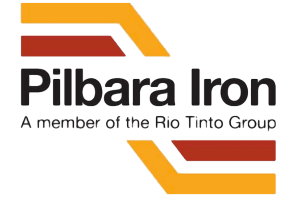
Pilbara Iron is a wholly owned subsidiary of the multinational Rio Tinto Group, that manages assets for Hamersley Iron Pty Ltd, a wholly owned subsidiary of Rio Tinto, and Robe River Iron Associates, an unincorporated joint venture between Rio and three Japanese steel companies Mitsui Iron Ore Development P/L (33%), Nippon Steel Australia P/L (10.5%) and Sumitomo Metal Australia P/L (3.5%).
The mining industry in India is a major economic activity which contributes significantly to the economy of India. The gross domestic product (GDP) contribution of the mining industry varies from 2.2% to 2.5% only but going by the GDP of the total industrial sector, it contributes around 10% to 11%. Even mining done on small scale contributes 6% to the entire cost of mineral production. Indian mining industry provides job opportunities to around 700,000 individuals.

Mining in Iran is still under development, yet the country is one of the most important mineral producers in the world, ranked among 15 major mineral-rich countries, holding some 68 types of minerals, 37 billion tonnes of proven reserves and more than 57 billion tonnes of potential reserves worth $770 billion in 2014. Mineral production contributes only 0.6 percent to the country's GDP. Add other mining-related industries and this figure increases to just four percent (2005). Many factors have contributed to this, namely lack of suitable infrastructure, legal barriers, exploration difficulties, and government control.
Betioky is a town in Atsimo-Andrefana Region, Madagascar and is crossed by the Route nationale 10. The population is 25,612 inhabitants in 2018.
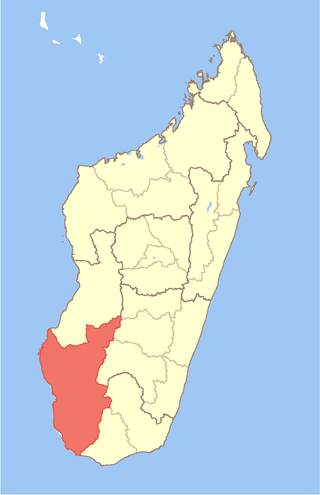
Atsimo-Andrefana is a region of Madagascar. It borders Menabe in north, Amoron'i Mania and Haute Matsiatra in northeast, Ihorombe and Anosy in east and Androy in southeast. The capital is Toliara and the population was 1,799,088 in 2018. Atsimo Andrefana is geographically the largest of all Malagasy regions with an area of 66,236 km2 (25,574 sq mi).
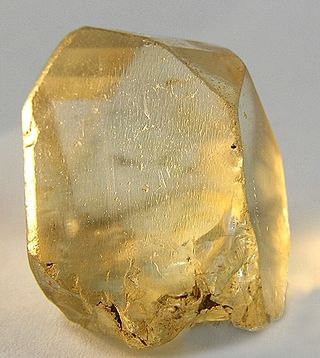
The mining of minerals in Nigeria accounts for only 0.3% of its gross domestic product, due to the influence of its vast oil resources. The domestic mining industry is underdeveloped, leading to Nigeria having to import minerals that it could produce domestically, such as salt or iron ore. The rights to ownership of mineral resources is held by the Federal Government of Nigeria, which grants titles to organizations to explore, mine, and sell mineral resources. Organized mining began in 1903, when the Mineral Survey of the Northern Protectorates was created by the British colonial government. A year later, the Mineral Survey of the Southern Protectorates was founded. By the 1940s, Nigeria was a major producer of tin, columbite, and coal. The discovery of oil in 1956 hurt the mineral extraction industries, as government and industry both began to focus on this new resource. The Nigerian Civil War in the late 1960s led many expatriate mining experts to leave the country. Mining regulation is handled by the Ministry of Solid Minerals Development, who are tasked with the responsibility of overseeing the management of all mineral resources in Nigeria. Mining law is codified in the Federal Minerals and Mining Act of 1999. Historically, Nigeria's mining industry was monopolized by state-owned public corporations. This led to a decline in productivity in almost all mineral industries. The Obasanjo administration began a process of selling off government-owned corporations to private investors in 1999. The Nigerian Mining Industry has picked up since the "Economic Diversification Agenda", from Oil & Gas, to Agriculture, Mining, etc., began in the country.
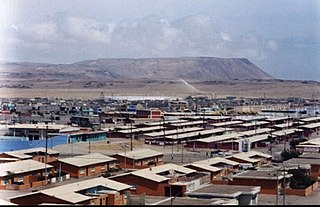
Marcona District is one of five districts of the province Nazca in Peru. The district capital is San Juan de Marcona a port on the Pacific coast.
The mineral industry of Russia is one of the world's leading mineral industries and accounts for a large percentage of the Commonwealth of Independent States' production of a range of mineral products, including metals, industrial minerals, and mineral fuels. In 2005, Russia ranked among the leading world producers or was a significant producer of a vast range of mineral commodities, including aluminum, arsenic, cement, copper, magnesium compounds and metals, nitrogen, palladium, silicon, nickel and vanadium.

Mining in the United Kingdom produces a wide variety of fossil fuels, metals, and industrial minerals due to its complex geology. In 2013, there were over 2,000 active mines, quarries, and offshore drilling sites on the continental land mass of the United Kingdom producing £34bn of minerals and employing 36,000 people.
Mining is an important industry in Pakistan. Pakistan has deposits of several minerals including coal, copper, gold, chromite, mineral salt, bauxite and several other minerals. There are also a variety of precious and semi-precious minerals that are also mined. These include peridot, aquamarine, topaz, ruby, emerald, rare-earth minerals bastnaesite and xenotime, sphene, tourmaline, and many varieties and types of quartz.
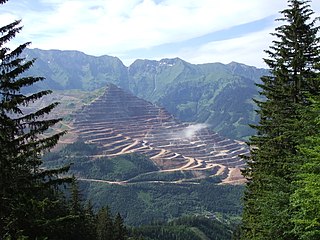
The Erzberg mine is a large open-pit mine located in Eisenerz, Styria, in the central-western part of Austria, 60 km north-west of Graz and 260 km south-west of the capital, Vienna. Erzberg represents the largest iron ore reserves in Austria, having estimated reserves of 235 million tonnes of ore. The mine produces around 2,153,000 tonnes of iron ore per year. It is also the site of the annual Erzberg Rodeo hard enduro race.
Mining in North Korea is important to the country's economy. North Korea is naturally abundant in metals such as magnesite, zinc, tungsten, and iron; with magnesite resources of 6 billion tonnes, particularly in the North and South Hamgyong Province and Chagang Province. However, often these cannot be mined due to the acute shortage of electricity in the country, as well as the lack of proper tools to mine these materials and an antiquated industrial base. Coal, iron ore, limestone, and magnesite deposits are larger than other mineral commodities. Mining joint ventures with other countries include China, Canada, Egypt, and South Korea.
The Cacova Ierii mine is a large open pit mine in the north-western of Romania in Cluj County. Cacova Ierii represents one of the largest iron ore reserves in Romania having estimated reserves of 16.6 million tonnes of ore grading 42% iron metal. The mine has the capability to produce around 415,000 tonnes of iron ore/year.
The Soalala mine is a large iron mine located in northern Madagascar in Boeny in Soalala. It represents one of the largest iron ore reserves in Madagascar and in the world having estimated reserves of 360 million tonnes of ore grading 35% iron metal.
The Fenoarivo mine is a large iron mine located in central Madagascar in Haute Matsiatra, near Fenoarivo, Ambalavao. Fenoarivo represents one of the largest iron ore reserves in Madagascar and in the world having estimated reserves of 100 million tonnes of ore grading 40% iron metal.
The Green Giant mine is one of the largest vanadium mines in Madagascar. The mine is located in Betioky Sud in Atsimo-Atsinanana. The mine has reserves amounting to 59.2 million tonnes of ore grading 0.68% vanadium. In August of 2007, the Canadian company Uranium Star Corp announced an agreement where it would buy a 75% ownership stake in the mine from Madagascar Minerals and Resources Sarl, and then bought full ownership in 2009. An aerial survey was conducted in 2007 and samples were drilled in 2008. Uranium Star Corp rebranded as Energizer Resources Inc in December 2009, and then as NextSource Materials Inc in April 2017. The mine is 11 kilometers from the Molo mine, which is also owned by NextSource.

The mining industry of Madagascar is mostly on a small scale, centred mainly around remote locations with large mineral deposits. Mining potential is noted in industrial and metallic minerals, energy, precious and semi-precious stones, as well as ornamental stone. The mining sector was neglected by the government for decades prior to the mid-2000s. In 2013, the mining industry, a main source of foreign investment, was struggling due to "low metals prices and distrustful companies", attributed to a 2009 coup.
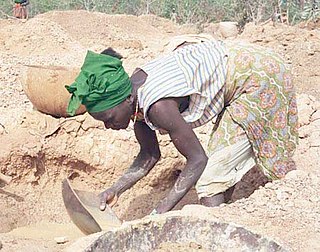
The mining industry of Guinea was developed during colonial rule. The minerals extracted consisted of iron, gold, diamond, and bauxite. Guinea ranks first in the world in bauxite reserves and 6th in the extraction of high-grade bauxite, the aluminium ore. The mining industry and exports of mining products accounted for 17% of Guinea's gross domestic product (GDP) in 2010. Mining accounts for over 50% of its exports. The country accounts for 94% of Africa's mining production of bauxite. The large mineral reserve, which has mostly remained untapped, is of immense interest for international firms.

The mining industry of Morocco is important to the national economy. Morocco is the world's largest producer of phosphate, and contains about 75% of the world's estimated reserves. Mining contributed up to 35% of exports and 5% of GDP in 2011. Foreign investors have found the investment climate, the infrastructure, fiscal situation, and political stability very favorable to continue business in the country in this sector.
References
- ↑ "Mining industry of Madagascar" (PDF). minerals.usgs.gov. Retrieved 2013-07-28.